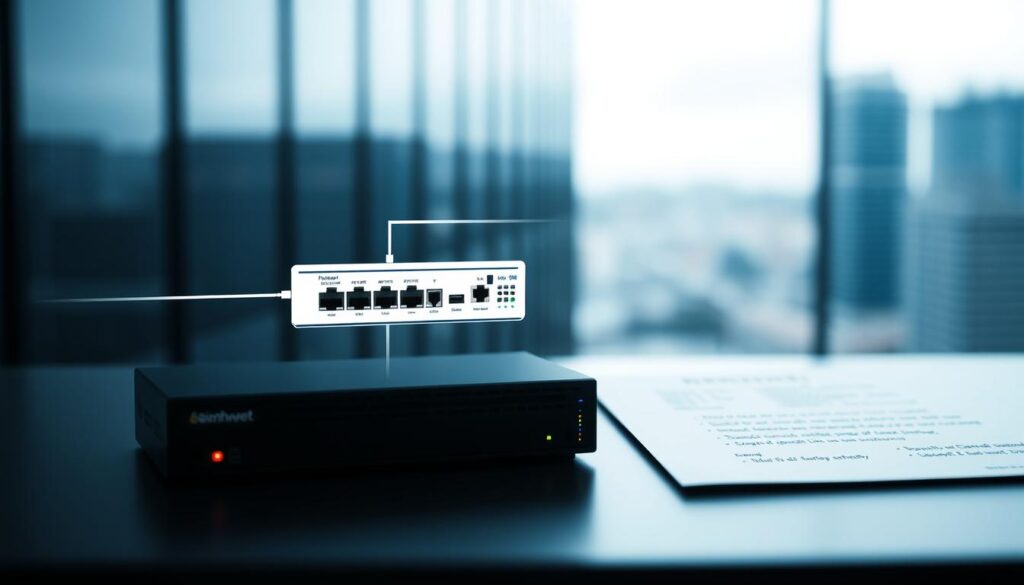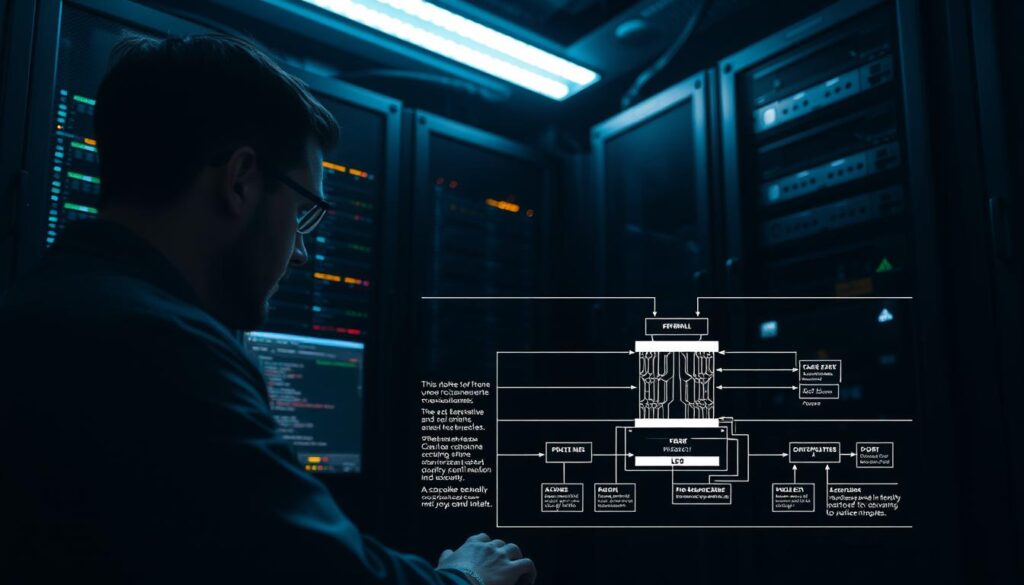This introduction outlines a practical, vendor-agnostic path to plan, secure, configure, validate, and maintain a production-ready device that protects critical assets in real time.
The guide focuses on business-grade devices with stateful inspection and multiple network zones. It explains core elements like DMZ and internal zone design, IPv4 private addressing with NAT, VLANs, and access control lists that end with a deny all.
Before any exposure, update firmware, remove default accounts, enforce unique credentials, and restrict management to trusted subnets. Enable needed services—DHCP, NTP, IPS—centralize logs to meet PCI DSS 10.2–10.3, and keep secure backups with rollback plans.
Validate the setup with functional tests, vulnerability scans, and penetration testing. Maintain an operational cadence: monitor logs, review rules at least every six months, and document every change for accountability.
Key Takeaways
- Plan the network structure and define DMZ versus internal zones.
- Harden admin accounts, update firmware, and restrict management planes.
- Build specific ACLs; finish with a deny-all policy.
- Centralize logs to meet compliance and enable effective monitoring.
- Test functionality and security, and keep tested backups for rollback.
Understanding the Goal: Network Security Basics and How This Guide Works
This section explains core objectives and the practical scope you will cover. The aim is to protect data flows, enforce clear policy between zones, and validate that controls work in production.
What a firewall does versus what it doesn’t
A firewall enforces policy between networks and zones. It inspects sessions and applies rules to allow needed access while blocking unapproved traffic.
Firewalls are not a cure-all. They do not replace patching, endpoint tools, or user training. Treat the device as one control in a layered program.
User intent: secure, configure, and validate now
This guide helps you lock down configuration, apply least privilege, and prove effectiveness through testing and logs. Be specific: map rules to business services and resources and avoid broad permits.
“Misconfiguration remains the leading cause of incidents; enforce defaults removal and verify every rule.”
| Capability | What it Enforces | What it Does Not Fix |
|---|---|---|
| Stateful inspection | Tracks sessions, allows return traffic | Unpatched servers |
| Access rules | Granular source/dest/port control | Weak credentials |
| Zone separation | Limits lateral movement | Poor application security |
| Logging & auditing | Supports compliance and review | Automatic threat removal |
- Watch defaults: default accounts and cleartext protocols like Telnet or HTTP risk credential exposure.
- Direction matters: inbound rules control entry; outbound rules reduce egress and exfiltration risk.
- Document everything: logs and change records meet internal and external requirements and support accountability.
Pre‑Setup Security Hardening for Your Firewall
Begin by locking the device’s control plane. Apply vendor-recommended updates and remove default credentials before the device sees untrusted networks.
Update firmware and disable default accounts/passwords
Update firmware to the latest vendor-recommended release to patch known vulnerabilities and improve stability.
Delete, rename, or disable default accounts and replace default passwords with strong, unique passphrases stored in a secure manager.
Lock down management access
Create per-user admin accounts with role-based privileges. Never use shared accounts so every change is attributable.
Restrict management access to trusted corporate subnets, require multifactor authentication where available, and use IP allowlists for the admin plane.
Harden protocols and track changes
Disable plaintext protocols such as Telnet and HTTP. Review SNMP and either disable it or use secure community strings and versioning.
Log all administrative actions—login attempts and configuration changes—for forensics and compliance.
| Task | Recommended Action | Why it Matters |
|---|---|---|
| Firmware | Install vendor-recommended release | Patches vulnerabilities and adds stability |
| Accounts & passwords | Remove defaults; create per-user accounts; use passphrases | Prevents credential reuse and enables accountability |
| Management access | Restrict to trusted subnets; require MFA; use VPN for remote | Reduces exposure of the management plane |
| Protocols & logging | Disable Telnet/HTTP; secure or disable SNMP; centralize logs | Stops cleartext leaks and supports audits |
Design Network Zones and IP Address Structure
Designing clear zones and an address plan reduces risk and makes troubleshooting faster. Begin by inventorying assets and grouping them by business function and sensitivity. Map those groups into discrete network zones to limit the blast radius if one service is compromised.
DMZ, internal server zones, and user networks
Place internet-facing services—web, email, and vpn—into a DMZ that allows only the minimal inbound ports required. Prevent direct reach from the DMZ to internal server zones.
Keep databases and non‑internet servers in protected internal segments with stricter east‑west rules. Segment endpoints (workstations, POS, VoIP) into separate internal networks and apply role-based policies to reduce lateral movement.
IPv4 private addressing, NAT, and VLAN segmentation
Use RFC1918 addresses for all internal networks and define a clear addressing plan to avoid overlaps across sites. Configure NAT for outbound internet access and publish only specific services with tightly controlled inbound NAT rules.
Implement VLANs on switches to enforce Layer 2 separation that mirrors your zone model. Finally, assign each zone to a descriptive firewall interface or subinterface and keep a living diagram showing zones, addresses, interfaces, and dependencies for audits and troubleshooting.
- Reserve address blocks for growth to avoid disruptive renumbering.
- Document VLAN IDs and trunking to the firewall interfaces to reduce misconfiguration risk.
- Maintain an inventory and topology diagram for operational clarity.
Setting Up a Firewall: Interface Mapping and Initial Configuration
Start configuration by mapping zone names to interfaces and confirming VLAN tags match your network diagram.

Map zones to interfaces and tune basics
Create the defined zones on the firewall and bind each to the correct physical interface or subinterface. Set addressing, MTU, and administrative state, and verify link status.
If you run HA pairs, confirm redundancy and failover behavior before enabling production traffic. Label each interface-to-zone mapping with VLAN IDs and IP ranges for operations and audits.
Time, DHCP, and minimal services
Configure NTP so logs share a consistent timeline across the network. Enable DHCP only on interfaces serving client endpoints and define scopes, reservations, and options like DNS and NTP.
Disable unused services to reduce the attack surface. Keep admin interfaces off public access and restrict management access by interface to trusted subnets only.
- Apply minimal acls during initial bring-up to prevent accidental open access.
- Verify routing, default routes, and NAT for internet-bound subnets to avoid asymmetry.
- Validate baseline reachability—gateway pings, DNS resolution, and time sync—before moving to full policy build.
Create and Tune Access Control Lists (ACLs)
Craft access control rules that map precisely to business services and known IP endpoints. Start with an allowlist mindset: document exact source and destination IPs, ports, and protocols for each flow. Keep entries tight to reduce exposure.
Permit only required sources, destinations, and ports
Define specific hosts and port numbers for every rule. Avoid broad subnets or any/any permits. Name rules clearly and link them to ticket or change IDs for traceability.
Apply inbound and outbound ACLs with a final deny-all
Attach acls to each interface and subinterface in both directions. End each list with a strong, explicit deny all to enforce default-deny.
Use categories and next‑gen controls
Where supported, combine firewall rules with category-based web filtering, IPS, and file sandboxing. Log critical matches and recertify policies with app owners on a schedule.
| Best Practice | Action | Why It Matters |
|---|---|---|
| Allowlist | Exact IPs/ports per rule | Limits unintended traffic |
| Bi-directional ACLs | Apply on each interface | Prevents unauthorized ingress/egress |
| Next‑gen controls | Enable IPS and web categories | Deeper inspection and threat reduction |
Configure Firewall Services, Logging, and Visibility
Enable only the network services you need and turn off any extras to reduce exposure. Run DHCP only for client subnets and enable NTP so events share accurate timestamps. Turn on intrusion prevention where the device supports it and disable unused features to shrink the attack surface.
Enable core services and minimize extras
Keep service scope tight. Only enable DHCP servers, NTP, and IPS/IDS modules when required by business flows. Disable management or application features that are not in use.
Centralize logs to meet compliance
Configure detailed logging for allow and deny actions, admin logins, configuration changes, and system events. Forward logs securely to a centralized SIEM or log server with retention that meets PCI DSS 10.2–10.3 requirements.
- Include fields: timestamp, user, source/destination IPs, ports, action, and rule hit.
- Set severity thresholds and rate limits to reduce noise while keeping critical events.
- Use dashboards to track denied connections, IPS alerts, and top talkers across networks.
- Test log integrity and time sync; alert on repeated failed admin logins or policy changes.
Document service and logging configurations so management and audits can reproduce them consistently.
Validate the Configuration: Testing, Scanning, and Backups
Run controlled tests before any production rollout. Prove that intended services work and that denied flows are consistently blocked. Capture results and link them to change records for traceability.
Functional testing: allowed vs. blocked flows
Perform scripted tests that exercise common application paths and known-deny scenarios. Verify NAT and routing in both inbound and outbound directions to catch asymmetry.
Collect logs and confirm they show rule hits, session details, and timestamps for audit and troubleshooting.
Vulnerability scanning and penetration testing
Run vulnerability scans to find exposed services, weak ciphers, and missing patches seen through the device. Schedule periodic penetration testing to validate exploit resistance and uncover rule gaps.
Secure configuration backups and rollback drills
Encrypt full running configuration backups and restrict restore rights to authorized staff. Conduct rollback drills to a known-good state and test HA failover, session sync, and health checks.
| Activity | Purpose | Success Criteria |
|---|---|---|
| Functional testing | Confirm allowed traffic and blocked flows | All test cases pass; denied attempts logged |
| Vulnerability scan | Identify exposed services and weak ciphers | Low-severity findings or documented mitigations |
| Penetration test | Validate resistance to real exploits | No critical gaps; remediation verified |
| Backup & rollback | Ensure quick recovery of configuration | Restore completes within RTO; services functional |
Ongoing Firewall Management and Rule Lifecycle
Ongoing care keeps policy effective and prevents drift as networks and business needs change.
Establish a clear maintenance cadence to update firewall firmware promptly when vendors release security fixes. Review rules with stakeholders at least every six months to remove stale entries and tighten scopes.

Monitor logs continuously, tune noisy events, and investigate anomalies that may signal policy gaps or threats. Track configuration drift and store approved configs in a versioned repository with change histories.
Re-test critical paths after major rule or topology changes to catch unintended side effects early. Align rule lifecycle with application lifecycles so rules are added, modified, or removed as services change.
- Train admins on change control and peer review to reduce errors.
- Maintain inventory of service accounts, certificates, and dependencies tied to policies.
- Measure rule count, hit rates, deny rates, and IPS events to guide simplification.
- Periodically assess management access and enforce MFA for authorized personnel.
Consistent management, measurement, and documentation keep firewalls protecting critical assets and enable timely, auditable updates.
Avoid Common Misconfigurations and Pitfalls
Small oversights in rule design or management controls can cause large outages or enable data loss. Be deliberate: focus on the policies that directly protect critical resources and business flows.
Overly broad rules, ignoring egress, and stale services
Do not use broad any-any permits. These hide misconfigurations and can break DNS or connectivity when changes occur.
Control egress to reduce data exfiltration and command-and-control callbacks. Treat outbound traffic with the same rigor as inbound.
Remove unused published services and audit NAT and port forwards. Forgotten exceptions become attack paths and waste resources.
Change control, documentation, and accountability
Document every change. Enforce peer reviews and change control to catch risky edits before deployment.
Limit who can modify configuration and record who changed what and why. This keeps accountability clear and helps meet compliance requirements.
- Avoid rule shadowing or duplication that complicates troubleshooting.
- Validate DNS, NTP, and other foundational services through the device to prevent subtle failures.
- Simulate failures periodically to ensure detection and fast recovery.
Conclusion
, This conclusion ties configuration choices to measurable security outcomes for production networks. Keep admin access hardened, map clear zones and addresses to interfaces, and apply narrow ACLs that enforce both inbound and outbound access with a final deny-all.
Turn on only essential services such as DHCP, NTP, and IPS, secure management protocols, and centralize logging to meet compliance and speed investigations. Validate with functional tests, vulnerability scanning, and penetration testing, and keep encrypted backups and rollback plans ready.
Make configuration a living artifact: schedule firmware updates, review rules regularly, monitor logs, and retire stale exceptions. With disciplined management and clear naming for zones, servers, and rules, your firewall configuration will protect data and resources in production.
FAQ
What is the main purpose of a firewall in network security?
A firewall enforces access control between network zones by inspecting traffic and allowing or denying flows based on rules. It protects internal servers and user networks from unauthorized access, limits exposed services in a DMZ, and can integrate intrusion prevention, VPN termination, and logging for visibility.
How do I begin configuring interfaces and mapping zones?
Identify physical and subinterfaces, assign each to a zone (internal, DMZ, internet), and document IP addressing and VLAN tags. Configure management, time/NTP, and baseline services before adding access control rules so initial connectivity and logging are reliable.
Which pre‑setup hardening steps are essential?
Update firmware, disable default accounts and passwords, and enforce least‑privilege for admin access. Disable insecure protocols like Telnet and HTTP, and lock down SNMP. Use role‑based access and avoid shared admin accounts to reduce risk.
How should I design network zones and IP addressing?
Segment by function: DMZ for public services, separate internal server zones, and user networks. Use private IPv4 ranges with NAT to the internet and apply VLANs to isolate traffic. Document the IP plan and map it to ACLs and routing.
What are the best practices for creating ACLs?
Start with a deny‑all default and explicitly permit required source/destination IPs and ports. Apply inbound and outbound ACLs where appropriate, restrict egress traffic, and group services to simplify rules. Enable next‑gen controls like application awareness where available.
How do I balance logging and performance?
Centralize logs to a syslog or SIEM and tune log levels to capture critical events without overwhelming storage. Log denied and suspicious flows, but sample or summarize high‑volume benign traffic. Retain logs per compliance needs, such as PCI DSS when applicable.
What testing should I perform after configuration?
Conduct functional tests to verify allowed flows and blocked flows, run vulnerability scans, and schedule penetration tests. Validate backups by performing rollback drills and verify that restores include configuration, certificates, and keys.
How often should I update rules and firmware?
Review rules continuously as part of change control and perform formal reviews quarterly or after major changes. Apply firmware and security updates promptly following vendor guidance, testing in a staging environment before production when possible.
What common misconfigurations cause the most risk?
Overly broad rules, missing egress controls, stale or unused services, and open management interfaces are frequent problems. Lack of documentation and weak change control increases the chance of mistakes and prolonged exposure.
How do I secure firewall management and admin accounts?
Enforce strong passwords, multi‑factor authentication, and role‑based access control. Restrict management to specific IPs or management VLANs, disable public admin access, and log all administrative actions for accountability.
Should I enable intrusion prevention and next‑generation features?
Yes — enable IPS/IDS, application identification, and URL filtering when available to block threats beyond simple port/port‑based ACLs. Tune signatures to reduce false positives and monitor impact on throughput.
What is the recommended approach for backups and rollback?
Automate encrypted configuration backups to a secure repository, keep versioned copies, and test restores regularly. Maintain a rollback plan and scripts that can be executed during incidents to restore a known good configuration quickly.

